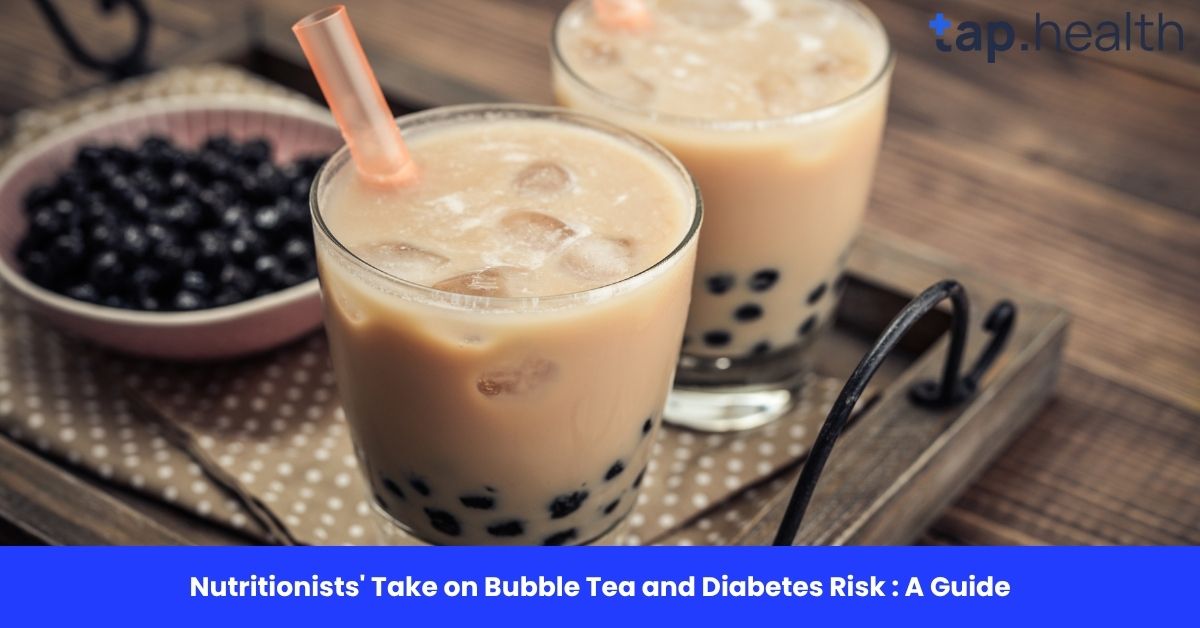Bubble tea, also known as boba tea, has become a global sensation over the last few decades. Originating in Taiwan, this fun and sweet beverage has captivated the hearts of millions, especially with its chewy tapioca pearls and customizable flavours. However, as bubble tea’s popularity soars, health concerns, particularly around its impact on diabetes risk, have emerged.
Nutritionists and health experts are particularly cautious about the sugar content and glycemic load of bubble tea, both of which can significantly affect insulin sensitivity and blood sugar levels. In this article, we’ll explore how bubble tea may affect people with diabetes, what ingredients to watch out for, and whether it’s safe to include bubble tea in your diet.
What is Bubble Tea?
Bubble tea is a beverage that combines tea, milk (or non-dairy alternatives), sweeteners, and chewy tapioca pearls. Often, the tea is brewed from black or green tea leaves, and the drink can be served either cold or hot. Variations of bubble tea include fruit tea, milk tea, and smoothies, with different toppings like popping boba, grass jelly, or sweetened red beans.
Key Ingredients in Bubble Tea
- Tea: Typically black, green, or oolong tea, which forms the base of most bubble tea recipes.
- Milk or Non-Dairy Milk: Cow’s milk, almond milk, oat milk, or coconut milk are commonly used.
- Sweeteners: Sugar, honey, or syrup is added for sweetness. Brown sugar syrup is a common choice.
- Tapioca Pearls: Made from tapioca starch, these chewy pearls provide the “bubbles” that give the drink its name.
- Additional Toppings: Some variants of bubble tea include popping boba, pudding, or jelly cubes for texture.
Nutritional Breakdown of Bubble Tea
The nutritional value of bubble tea can vary greatly depending on the ingredients used, but a typical 16-ounce (475 ml) serving of milk tea with tapioca pearls contains:
- Calories: 250–450 kcal
- Carbohydrates: 45–70g (depending on the sugar and syrup content)
- Sugars: 30–50g
- Fat: 5–12g (depends on the type of milk used)
- Protein: 3–5g
- Sodium: 50–100mg
- Fiber: 1–2g (from the tapioca pearls)
Key Nutrients in Bubble Tea
- Sugar: The major contributor to the high calorie and carbohydrate content, which directly impacts blood sugar levels.
- Fat: Fat content varies depending on the type of milk used, with full-fat dairy milk increasing fat content significantly.
- Caffeine: Bubble tea, made with tea, typically contains caffeine. While moderate caffeine intake has benefits, excess consumption can have negative effects, particularly on people sensitive to caffeine.
- Calcium: Milk-based bubble tea is a good source of calcium, which is essential for bone health, but the sugar content can offset some of its health benefits.
How Bubble Tea Affects Insulin Sensitivity
1. High Sugar Content and Its Effect on Insulin
The sugar in bubble tea, especially from syrups and sweeteners, can rapidly increase blood sugar levels. This is a concern for people with diabetes or insulin resistance, as consuming large amounts of sugar can cause insulin spikes.
- Insulin resistance occurs when the body’s cells don’t respond effectively to insulin, leading to higher blood sugar levels.
- Drinking sugary beverages like bubble tea can exacerbate insulin resistance, particularly if consumed regularly.
- A high intake of refined sugars in bubble tea increases the workload on the pancreas, which secretes insulin to regulate blood sugar levels.
2. Tapioca Pearls and Glycemic Index
Tapioca pearls, made primarily from starch, have a high glycemic index (GI). The glycemic index measures how quickly a food raises blood sugar levels after consumption.
- Foods with a high GI, like tapioca pearls, can lead to blood sugar spikes, which can be harmful to people with diabetes.
- The starch in tapioca pearls is quickly digested and converted into glucose, leading to a rapid increase in blood sugar.
3. Calories and Weight Gain
Bubble tea can also be a source of excess calories, particularly if large servings or high-calorie ingredients like full-fat milk or sugary syrups are used. Over time, consuming excess calories can contribute to weight gain, which is a major risk factor for the development of type 2 diabetes and worsens blood sugar control in individuals with diabetes.
- Obesity and excess fat accumulation around the belly can worsen insulin resistance and elevate the risk of metabolic syndrome and heart disease.
- Choosing smaller portions and lower-calorie versions of bubble tea can help reduce this risk.
Is Bubble Tea Safe for People with Diabetes?
For those with diabetes or anyone at risk of developing it, bubble tea should be consumed with caution. Here’s why:
1. Occasional Consumption vs. Regular Intake
- Occasional consumption of bubble tea may be fine for some people with diabetes, especially if portion sizes are controlled and sugar levels are kept to a minimum. However, regular consumption of high-sugar, high-calorie bubble tea can contribute to poor blood sugar management.
- A small-sized bubble tea with low sugar or no added sweeteners is less likely to have a significant impact on insulin sensitivity compared to larger servings with full sugar.
2. Choosing Sugar-Free or Low-Sugar Variants
Most boba shops now offer sugar-free or low-sugar options. Choosing these variants can significantly reduce the impact on blood sugar levels, although it’s still important to consider other ingredients like the glycemic index of tapioca pearls.
- Opt for sugar-free syrups, or choose to sweeten your drink with natural sweeteners like stevia or monk fruit.
- Many stores also allow you to customize the amount of sugar, so you can ask for half or less sugar than the regular amount.
3. Replacing Tapioca Pearls with Healthier Alternatives
Some boba shops offer alternatives to traditional tapioca pearls, such as chia seeds, popping boba, or jelly cubes, which may have a lower glycemic index and fewer calories. These alternatives can make the drink less likely to cause rapid blood sugar spikes.
- Chia seeds are rich in omega-3 fatty acids, fibre, and protein, and can help slow the absorption of sugars.
- Popping boba is typically filled with fruit juice and can have lower sugar content than traditional tapioca pearls.
Healthier Alternatives to Traditional Bubble Tea
If you love bubble tea but are concerned about its impact on your blood sugar levels, there are several ways to make the drink healthier:
1. Use Sugar-Free or Low-Sugar Sweeteners
Ask for sugar-free or low-sugar options when ordering your bubble tea. Many boba shops offer syrups made with sugar substitutes like stevia or monk fruit, which have little to no effect on blood sugar.
2. Opt for Non-Dairy Milk
Instead of regular dairy milk, choose plant-based milk options like almond milk, oat milk, or coconut milk, which are lower in calories and sugars compared to cow’s milk.
3. Choose Smaller Sizes
Opt for a small-sized bubble tea and avoid super-sized drinks. This will help you limit the sugar and calorie intake while still enjoying the drink.
4. Go for Fresh Fruit Teas
Instead of milk-based teas, try fruit teas that are naturally lower in calories and sugars. Make sure to avoid adding syrups or sweeteners to keep the sugar content low.
5. Skip the Tapioca Pearls
Tapioca pearls are the most calorie-dense and high-glycemic ingredient in bubble tea. You can replace them with healthier toppings like chia seeds or popping boba that provide extra nutrients without spiking blood sugar levels.
Read this : How Many Calories in Boba? Full Nutritional Breakdown
Key Takeaways
- Bubble tea is a popular drink but can be high in sugar, calories, and starch, all of which may negatively affect insulin sensitivity and contribute to blood sugar spikes.
- The tapioca pearls in bubble tea have a high glycemic index and can cause rapid blood sugar increases, making them a concern for people with diabetes.
- Sugar-free or low-sugar variants of bubble tea are better options for those looking to manage blood sugar levels. Additionally, reducing portion size and choosing healthier toppings can help minimize the drink’s impact on insulin sensitivity.
- For a healthier bubble tea, choose plant-based milk, reduce or eliminate added sweeteners, and replace tapioca pearls with healthier alternatives like chia seeds or popping boba.
Frequently Asked Questions (FAQs) on Nutritionists’ Take on Bubble Tea and Diabetes Risk
Q1: Can people with diabetes drink bubble tea?
A1: People with diabetes can drink bubble tea occasionally, but it’s best to opt for low-sugar or sugar-free versions and choose healthier alternatives to tapioca pearls, such as chia seeds or popping boba.
Q2: How does bubble tea affect insulin sensitivity?
A2: Bubble tea, especially when high in sugar, can worsen insulin sensitivity by causing rapid blood sugar spikes. This can lead to insulin resistance over time if consumed regularly.
Q3: Is bubble tea high in sugar?
A3: Yes, most traditional bubble teas are high in sugar, with some servings containing up to 50 grams of sugar, which is well above the daily recommended intake.
Q4: Are there sugar-free options for bubble tea?
A4: Yes, many boba shops offer sugar-free syrups or allow customers to adjust the sweetness level, providing a healthier option for those managing blood sugar.
Q5: How can I make bubble tea healthier?
A5: To make bubble tea healthier, choose low-sugar versions, opt for plant-based milks, and replace tapioca pearls with healthier toppings like chia seeds or popping boba.
Q6: How much sugar is in a regular bubble tea?
A6: A regular 16-ounce serving of bubble tea can contain 30–50 grams of sugar, which is around 7–12 teaspoons of sugar.
Q7: Can bubble tea cause diabetes?
A7: Drinking bubble tea frequently, especially in large quantities with high sugar content, can increase the risk of type 2 diabetes due to its impact on insulin sensitivity and blood sugar control.
Q8: How often can I drink bubble tea if I have diabetes?
A8: It’s advisable to consume bubble tea in moderation, opting for smaller portions, sugar-free versions, and healthier toppings to reduce the impact on blood sugar levels.



